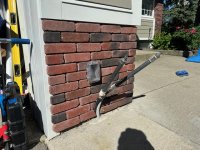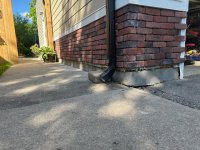That's a shite place to be using plywood.
You are using an out of date browser. It may not display this or other websites correctly.
You should upgrade or use an alternative browser.
You should upgrade or use an alternative browser.
Enough of COVID...what are you doing to the house?
- Thread starter mimico_polak
- Start date
48Connor
Well-known member
Yeah that would be idealOn the plus side, it sounds like the original install was dodgy. That can make repair easier. If you don't mind changing the look slightly, you could have the new framing run down at an angle to better support the window.
48Connor
Well-known member
Agreed.That's a shite place to be using plywood.
All I can tell is that it was installed pre 2007. It made it a decent amount of time
Salvaging houses with Habitat I have seen much worse. If you wrapped it, as is in aluminum and then could some how not think about it,it could likely be the next owners problem before it leaked.Agreed.
All I can tell is that it was installed pre 2007. It made it a decent amount of time
"Hello. My name is Kevin and I do renos.."
Mad Mike
Well-known member
Window installers are not usually carpenters, I've seen hundreds of windows installed where the structural integrity of framing is compromised.That was my original plan. It would appear that the 3/4" plywood is the framing, and everything underneath is simply there to support the fascia. If the window is cantilevered on the edge of the plywood, Im not sure if I can cut out a portion and slip a new one in
I've got a family friend who runs a home reno business coming over to see what his thoughts are.
Based on how your pic and the the age of your house, Ill bet your original windows were structural wood frames that supported the beam spanning the opening. Not uncommon for vinyl retrofits to compromise framing structure, particularly on big windows. .
Vinyl retrofits are not structural, so if the beam over the window relies on the original wooden window structure it will sag a little after a vinyl retrofit. The sag may not be noticeable to the eye, but it can cause the soffits to slope back to the house -- when this happens, moisture from condensation and eaves overflow runs toward the house and behind the window flashing -- leading to rot. Not saying that happened in your case, but there's a chance it did, seen that problem more than once.
The fix.
Your window is likely hanging off the vertical studs. and roof trusses, the plywood base is just a filler panel and not structural. If they window has been there for a decade, the beam over the window opening is probably going to last another 50 years.
Find the source of moisture. Check the slope on the soffits in front of the window, if they are sloping toward the house, fix that.
The rotten trim board 2x4s should come out easily. The bottom filler ply too. If you can't remove the whole bottom plywood piece, cut out the rotted edges and patch them with new ply pieces. Then laminate 1/2" ply PL glued and screwed to the bottom, replace the trim boards, refit the vinyl cap and calk.
Mad Mike
Well-known member
Those windows are designed to to hang off the vertical studs at the opening. They can be usually tied into the rafters for a little extra support. When you see framing below, it's usually there to provide a cavity for insulation -- not so much for support.Yeah that would be ideal
48Connor
Well-known member
That's some good info, thanks Mike.Window installers are not usually carpenters, I've seen hundreds of windows installed where the structural integrity of framing is compromised.
Based on how your pic and the the age of your house, Ill bet your original windows were structural wood frames that supported the beam spanning the opening. Not uncommon for vinyl retrofits to compromise framing structure, particularly on big windows. .
Vinyl retrofits are not structural, so if the beam over the window relies on the original wooden window structure it will sag a little after a vinyl retrofit. The sag may not be noticeable to the eye, but it can cause the soffits to slope back to the house -- when this happens, moisture from condensation and eaves overflow runs toward the house and behind the window flashing -- leading to rot. Not saying that happened in your case, but there's a chance it did, seen that problem more than once.
The fix.
Your window is likely hanging off the vertical studs. and roof trusses, the plywood base is just a filler panel and not structural. If they window has been there for a decade, the beam over the window opening is probably going to last another 50 years.
Find the source of moisture. Check the slope on the soffits in front of the window, if they are sloping toward the house, fix that.
The rotten trim board 2x4s should come out easily. The bottom filler ply too. If you can't remove the whole bottom plywood piece, cut out the rotted edges and patch them with new ply pieces. Then laminate 1/2" ply PL glued and screwed to the bottom, replace the trim boards, refit the vinyl cap and calk.
The source of the water appears to be that the bottom flashing didn't meet perfectly with the window, and the original installer used caulking to fill the gap. Over the year the caulking cracked and a hole opened up. Very isolated issue it appears
My guess would be what you found , as Mike said , likely the ply was just a filler panel and the crappy flashing / caulking install caused the rot . Put a level on the interior sill to see if the window has settled / dropped significantly. If it’s mostly level , build a new skirt and reflash and call it a day. As long as the rot is not back into the interior wall it’s no big deal . My last house had a big bay / installer put two short chains and turnbuckles up the the rafter tails and adjusted till plumb. Zero settling. Overkill but very effective.
Sent from my iPhone using GTAMotorcycle.com
Sent from my iPhone using GTAMotorcycle.com
Sadly a lot of contractors don't use journeymen but instead use "Installers" with little understanding of the long term aspects of their work.Window installers are not usually carpenters, I've seen hundreds of windows installed where the structural integrity of framing is compromised.
Based on how your pic and the the age of your house, Ill bet your original windows were structural wood frames that supported the beam spanning the opening. Not uncommon for vinyl retrofits to compromise framing structure, particularly on big windows. .
Vinyl retrofits are not structural, so if the beam over the window relies on the original wooden window structure it will sag a little after a vinyl retrofit. The sag may not be noticeable to the eye, but it can cause the soffits to slope back to the house -- when this happens, moisture from condensation and eaves overflow runs toward the house and behind the window flashing -- leading to rot. Not saying that happened in your case, but there's a chance it did, seen that problem more than once.
The fix.
Your window is likely hanging off the vertical studs. and roof trusses, the plywood base is just a filler panel and not structural. If they window has been there for a decade, the beam over the window opening is probably going to last another 50 years.
Find the source of moisture. Check the slope on the soffits in front of the window, if they are sloping toward the house, fix that.
The rotten trim board 2x4s should come out easily. The bottom filler ply too. If you can't remove the whole bottom plywood piece, cut out the rotted edges and patch them with new ply pieces. Then laminate 1/2" ply PL glued and screwed to the bottom, replace the trim boards, refit the vinyl cap and calk.
Ok, in the absence of a good source, here is what I think is the decoder ring for bosch dishwasher model numbers.It looks like only two of the 500's have it. Bosch doesn't make it really easy to figure out why you would pick one of their 52 dishwashers.
Sample model #
SHE53C85N
SH - dishwasher
E - Handle/panel design. E is a big front touch panel, X is a bar with controls on top of door, S is a small centred handle with controls on top, P is a larger handle with front controls, V is cabinet front
5 - generation. Last years would have 4. Higher series have higher numbers. Have there been more iterations or just started at a higher number?
3 - A for 100, 3/5/8 for 300/500/800
C8 I have no idea. I can't find the pattern.
5 Colour 2 is white, 4 is black stainless,5 is stainless, 6 is black
N No water softener. UC if it has a water softener
Going down this rabbit hole started because Costco has a 300 on sale in store. Of course it is a unique model number to make it hard to cross shop. SHE43CM5N is $900 down from $1000. Closest widely available model is SHE53C85N ($1200 at costco online and everywhere else). I was wondering if this was a 100 in disguise for costco. Based on my decoder, no, it should be a 300. It does match the sound level of the 100plus though. I suspect the guts are a generation older in the costco machine. I think I'm going to pass after all that. The panel design is the ugliest option imo, it's a generation old and bosch air dry doesn't get great reviews for plastic (and we have lots of plastic). I think I'll hold out for an autoair 500 on sale (or 800 if the sale is crazy).
Alright brain trust…need some recommendations here.
1. Best way to make this…better…one of the last remnant of Kevin’s handiwork on the exterior…I want to tighten up the hoses that go under the pad to the front sprinkler system.

2. I kept the bottom 8” of concrete only to help with water. Cousins went too far down (top pic) on the one side of the house, and now I need to figure out how best to work on the left hand side of the house to make it even…

Thanks!
1. Best way to make this…better…one of the last remnant of Kevin’s handiwork on the exterior…I want to tighten up the hoses that go under the pad to the front sprinkler system.

2. I kept the bottom 8” of concrete only to help with water. Cousins went too far down (top pic) on the one side of the house, and now I need to figure out how best to work on the left hand side of the house to make it even…

Thanks!
You made the rest of the house look too good, you need to do something with those sprinkler lines. I would run them into a box with just the qr's sticking out (parallel to wall so you don't break them off).Alright brain trust…need some recommendations here.
1. Best way to make this…better…one of the last remnant of Kevin’s handiwork on the exterior…I want to tighten up the hoses that go under the pad to the front sprinkler system.
View attachment 68179
2. I kept the bottom 8” of concrete only to help with water. Cousins went too far down (top pic) on the one side of the house, and now I need to figure out how best to work on the left hand side of the house to make it even…
View attachment 68180
Thanks!
Do you have any brick left? Brick front face to behind downspout would look OK.
Or peel off brick where you didn't want it and parge the mess behind.
Mad Mike
Well-known member
Agree with @GreyGhost , pic 1 I’d remove the bottom 2 courses of zbrick and parge.Alright brain trust…need some recommendations here.
1. Best way to make this…better…one of the last remnant of Kevin’s handiwork on the exterior…I want to tighten up the hoses that go under the pad to the front sprinkler system.
View attachment 68179
2. I kept the bottom 8” of concrete only to help with water. Cousins went too far down (top pic) on the one side of the house, and now I need to figure out how best to work on the left hand side of the house to make it even…
View attachment 68180
Thanks!
The sprinkler lines look like they are setup to connect to a garden hose. If so, delete them at the house, install an ingrown sprinkler valve box into the grass or garden on the other side of the concrete.
What do you think the cost might be for someone to run wire and fit a new light box for a ceiling fan in a virgin ceiling? Access to the ceiling from above is pretty straightforward through an attic access hatch that’s about 12 ft linear distance to where the box needs to be placed. Attic has blown in insulation. Ceiling doesn’t appear to be anything exotic but it does have a spackled finish. There’s some available existing switches nearby on the wall to tie into already in place.
No idea what electricians charge for this kind of thing nowadays. I thought of doing it myself but sadly voiced that out loud and the wife said “no”. Something about “you’ll just fall through the ceiling”.
Do you need a building permit for this kind of thing?
No idea what electricians charge for this kind of thing nowadays. I thought of doing it myself but sadly voiced that out loud and the wife said “no”. Something about “you’ll just fall through the ceiling”.
Do you need a building permit for this kind of thing?
Technically you need a permit as it’s electrical work. Realistically … you decide. Sounds like a simple job, calling @oioioiWhat do you think the cost might be for someone to run wire and fit a new light box for a ceiling fan in a virgin ceiling? Access to the ceiling from above is pretty straightforward through an attic access hatch that’s about 12 ft linear distance to where the box needs to be placed. Attic has blown in insulation. Ceiling doesn’t appear to be anything exotic but it does have a spackled finish. There’s some available existing switches nearby on the wall to tie into already in place.
No idea what electricians charge for this kind of thing nowadays. I thought of doing it myself but sadly voiced that out loud and the wife said “no”. Something about “you’ll just fall through the ceiling”.
Do you need a building permit for this kind of thing?
For me…I’d just do it myself.
Last edited:
You can do electrical in your own home with an electrical permit and inspection.What do you think the cost might be for someone to run wire and fit a new light box for a ceiling fan in a virgin ceiling? Access to the ceiling from above is pretty straightforward through an attic access hatch that’s about 12 ft linear distance to where the box needs to be placed. Attic has blown in insulation. Ceiling doesn’t appear to be anything exotic but it does have a spackled finish. There’s some available existing switches nearby on the wall to tie into already in place.
No idea what electricians charge for this kind of thing nowadays. I thought of doing it myself but sadly voiced that out loud and the wife said “no”. Something about “you’ll just fall through the ceiling”.
Do you need a building permit for this kind of thing?
It would be interesting to know how much a sparkie wanted. Attic in the warm weather will add some premium for not wanting to be there. Blown in will add some premium for cleanup as unless you have a good collar, some always falls through hatch.
Definitely try to minimize activity in blown in. Ime, everytime someone moves through, it loses substantial height.
I’ve done the same job on our bungalow with blown in insulation. It’s not fun but doing it yourself has its own reward. So far I’ve been up there to install a dozen pot lights, run a dozen camera wires, install ceiling speakers, do a new light/switch, new power receptacle, etc.
Tall rubber boots work well. Pick a cooler day.
Tall rubber boots work well. Pick a cooler day.
I tuck pants into socks and wear running shoes.I’ve done the same job on our bungalow with blown in insulation. It’s not fun but doing it yourself has its own reward. So far I’ve been up there to install a dozen pot lights, run a dozen camera wires, install ceiling speakers, do a new light/switch, new power receptacle, etc.
Tall rubber boots work well. Pick a cooler day.
Doing it yourself you get to discover the joys of blocking ruining what you thought was an easy drop through the wall too.
@jc100 pop through the ceiling where you want the light. Go into attic, find the pole, and then clear some of the insulation to not let it fall down.
Cut out hole with one of those nice dust catchers you can put on a hole drill.
Easy peasy.
Cut out hole with one of those nice dust catchers you can put on a hole drill.
Easy peasy.






















